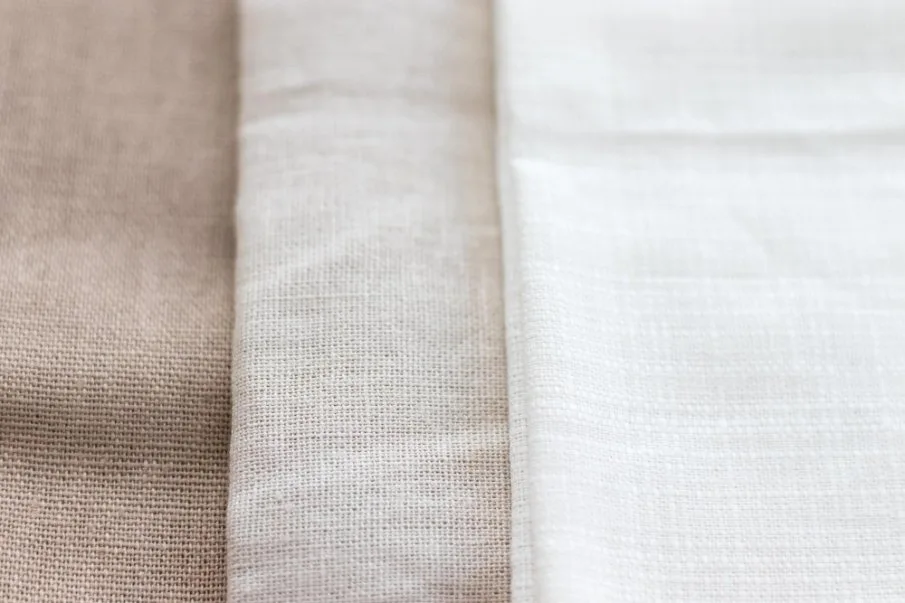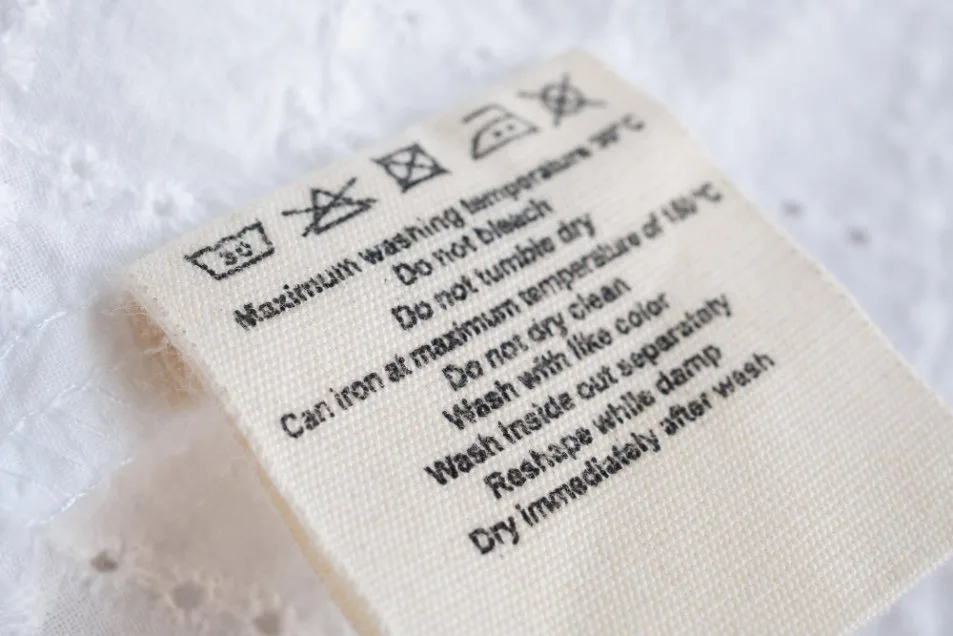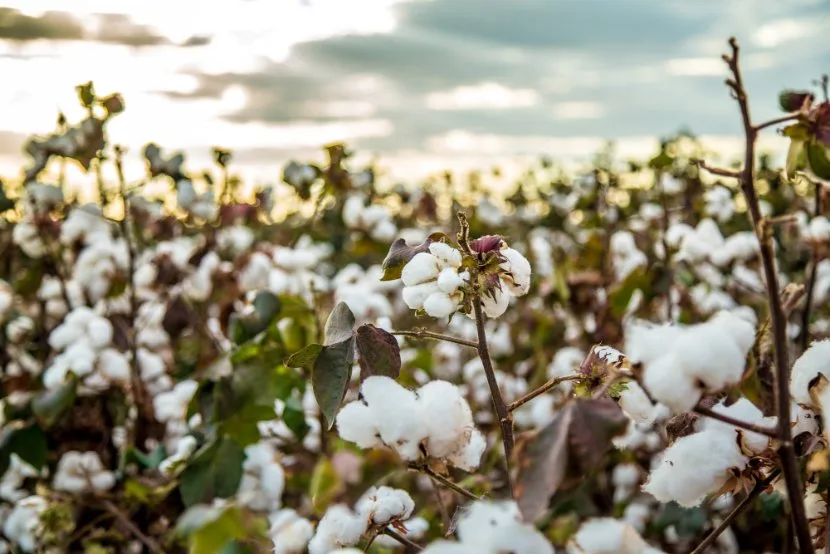Discover everything about cambric cotton, from its rich history to modern applications, care tips, and sustainable options
Quick Facts About Cambric Cotton
- Origin: Cambrai, France (14th century)
- Weight: 90-95 GSM (lightweight)
- Thread Count: 60-100 threads per inch
- Best Season: Spring, summer, and mild winter
- Key Features: Smooth finish, crisp feel, breathable
- Common Uses: Summer clothing, embroidery, bedding, formal wear
Table of Contents
- What is Cambric Cotton?
- History and Production
- Unique Properties and Benefits
- Types of Cambric Cotton
- Cambric vs Other Fabrics
- Technical Specifications
- Applications and Uses
- Sustainability and Certifications
- How to Identify Quality Cambric
- Care and Maintenance
- Buying Guide and Price Range
- Frequently Asked Questions
What is Cambric Cotton?
Cambric cotton is a lightweight, tightly woven cotton fabric known for its smooth surface and crisp texture. Unlike standard cotton materials, cambric goes through a special calendering process where heated rollers press the cloth to create its signature polished finish. This technique gives the fabric a subtle sheen while maintaining its breathable, natural qualities.
The fabric stands out for its plain-weave construction, where threads interlace tightly to produce a smooth, matte surface. This tight weave not only creates a refined appearance but also adds durability, making cambric resistant to pilling and fraying even with regular use.
Is Cambric 100% Cotton?
Most cambric today is made from 100% cotton, though historically it started as linen. Modern cambric typically uses high-grade American or Egyptian cotton fibers, spun into fine yarns ranging from 60 to 80 count. Some manufacturers also produce cotton-linen blends or polyester blends for specific applications, but pure cotton cambric remains the most popular choice for clothing and home textiles.
What Does Cambric Fabric Feel Like?
Cambric has a distinctive feel that sets it apart from other lightweight cottons. The fabric feels smooth and slightly crisp to the touch, with a firmer hand than voile or batiste. When you run your fingers across cambric, you’ll notice its fine, even texture and subtle stiffness. Despite this structured feel, the fabric drapes beautifully and softens with each wash while maintaining its shape.
History and Production of Cambric Fabric
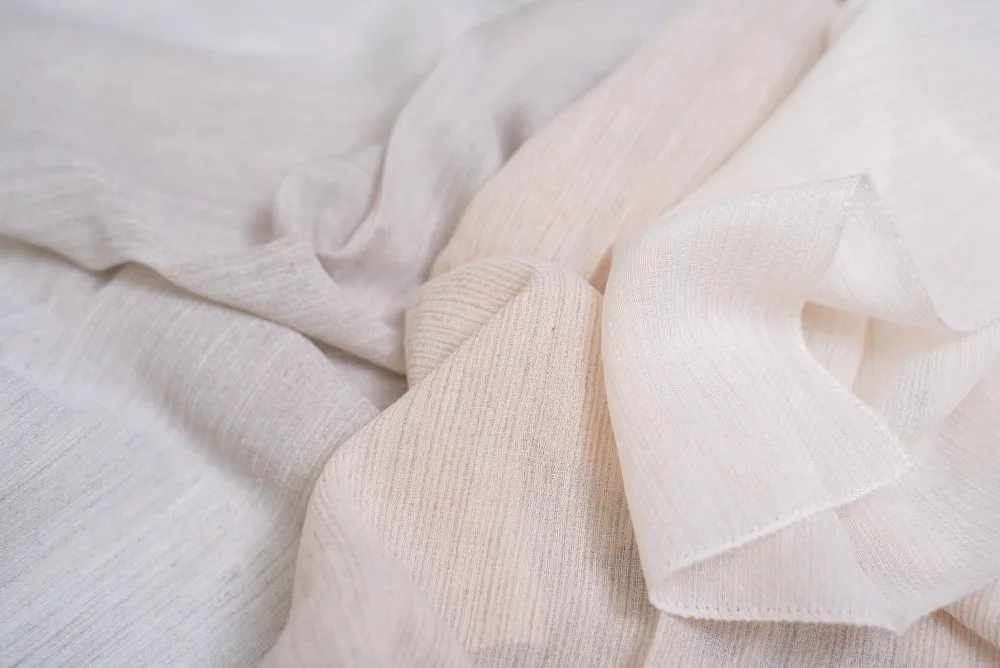
Origins in Medieval France
The story of cambric begins in 14th century Cambrai, France, where skilled artisans near the Scheldt River perfected a revolutionary cloth-making technique. The city’s Flemish name, Kameryk, gave birth to the fabric’s English name when France annexed the region in 1677.
Originally, cambric was crafted from flax-based linen using advanced loom techniques that achieved unprecedented thinness. Medieval guild masters prided themselves on creating fabric so fine it seemed to engineer air itself. By the 1600s, bleached linen cambric had become synonymous with luxury, preferred for ecclesiastical wear, fine shirts, and delicate handkerchiefs.
Evolution to Cotton Production
The Industrial Revolution transformed cambric production dramatically. When cotton imports surged in the 1700s, mills began experimenting with blended fibers before transitioning fully to cotton. This shift made the fabric more affordable and accessible while maintaining its desirable properties.
Today’s cambric production combines traditional craftsmanship with modern technology. Mills use 60-80 count yarns so fine that one pound can stretch 60 miles. The calendering process, once done with stone presses, now uses precisely controlled heat-treated rollers to achieve the fabric’s characteristic smooth finish.
What is Another Name for Cambric Cotton?
Cambric is also known as batiste, particularly in French-speaking regions and when used for needlework. The term “batiste” reportedly honors Jean Baptiste, the French weaver credited with perfecting the fabric in the 14th century. While some textile experts consider cambric and batiste identical, others note subtle differences in finishing techniques. In modern usage, “cambric” typically refers to patterned or colored fabric, while “batiste” often describes plain white fabric used for heirloom sewing and christening gowns.
Unique Properties and Benefits of Cambric Cotton

Lightweight, Soft, and Breathable Texture
Cambric’s lightweight nature makes it exceptionally comfortable for warm weather wear. The fabric typically weighs between 90-95 GSM (grams per square meter), placing it in the perfect range for summer clothing that needs structure without bulk. Use our Fabric Weight Calculator to understand how cambric compares to other fabrics for your project.
The tight plain weave allows excellent airflow while maintaining opacity. Unlike sheer fabrics, cambric provides adequate coverage for most garments without requiring lining. This breathability extends to temperature regulation, with moisture-wicking capabilities that prevent fabric from clinging during humid conditions.
Durability and Resistance to Wear
Despite its delicate appearance, cambric outperforms many standard cotton weaves in longevity. The heat-treated rollers used during production compress fibers into a dense matrix that resists abrasion. This densely packed structure minimizes pilling even after machine drying and maintains color vibrancy through dozens of wash cycles.
The fabric’s shape preservation comes from its low-stretch yarns and tight weave. Garments made from cambric hold their silhouette better than looser weaves, making them particularly suitable for tailored pieces that need to maintain crisp lines throughout the day.
Does Cotton Cambric Stretch?
Pure cotton cambric has minimal stretch due to its tight plain weave construction. The fabric may give slightly when pulled but quickly returns to its original shape. This lack of stretch contributes to cambric’s ability to maintain a structured, polished appearance. Some modern cambric blends incorporate a small percentage of elastane or spandex (typically 2-5%) for applications requiring more flexibility, such as fitted shirts or activewear.
Is Cambric Cotton Good for Sensitive Skin?
Yes, cambric cotton is an excellent choice for sensitive skin. As a natural fiber fabric, it’s hypoallergenic and less likely to cause irritation compared to synthetic materials. The smooth finish means fewer rough fibers that could scratch delicate skin, while the breathability prevents moisture buildup that can lead to rashes or discomfort.
The fabric’s ability to wick moisture away from the body helps maintain skin health by reducing bacterial growth. For babies and children with sensitive skin, organic cambric provides an extra layer of protection by eliminating exposure to pesticides and harsh chemicals used in conventional cotton farming.
Types of Cambric Cotton

Cambric comes in several varieties, each suited to specific applications and style preferences. Understanding these types helps you choose the right fabric for your project.
Plain Cambric
The classic unpatterned version with a smooth, uniform surface. Ideal for formal wear, undergarments, and as a base for embroidery. Available in white, natural, or solid colors with a subtle sheen from calendering.
Printed Cambric
Features vibrant patterns created through digital or screen printing. Popular in fashion for dresses, blouses, and tunics. The tight weave holds prints crisply without bleeding, making it perfect for detailed designs.
Dyed Cambric
Piece-dyed for solid colors with excellent color retention. The smooth surface showcases deep, rich hues beautifully. Often used for formal shirts, skirts, and tailored garments.
Striped Cambric
Classic woven or printed stripes that add visual interest without overwhelming the fabric’s refined nature. Common in menswear, children’s clothing, and home textiles like curtains.
Lace-Trimmed Cambric
Combines cambric’s crisp structure with delicate lace edging or broderie anglaise inserts. Perfect for heirloom garments, vintage-inspired clothing, and special occasion wear.
Swiss Cambric/Nelona
The premium tier with ultra-fine weave (100+ threads per inch) and exceptional softness. Historically made by specific Swiss manufacturers, true Nelona represents the highest quality cambric available for christening gowns and luxury garments.
What is 60-60 Cambric Cotton?
The term “60-60 cambric” refers to the thread count specification, indicating 60 threads per inch in both the warp (lengthwise) and weft (crosswise) directions. This creates a balanced weave with 3,600 thread intersections per square inch. This mid-range thread count offers a good balance between breathability, durability, and affordability, making it suitable for everyday clothing, bedding, and general-purpose textiles.
Cambric vs Other Lightweight Fabrics
Understanding how cambric compares to similar fabrics helps you make informed decisions for sewing projects or clothing purchases. Here’s a detailed comparison of cambric with commonly confused fabrics.
| Feature | Cambric | Lawn | Voile | Batiste |
|---|---|---|---|---|
| Weight (GSM) | 90-95 | 70-80 | 60-70 | 80-90 |
| Thread Count | 60-80 | 80-100 | 50-70 | 90-100 |
| Sheerness | Semi-opaque | Barely sheer | Semi-sheer | Semi-sheer |
| Texture | Crisp, smooth | Crisp, glossy | Soft, slightly textured | Soft, silky |
| Drape | Structured | Holds some shape | Fluid, flowy | Gentle drape |
| Best For | Shirts, dresses, embroidery | High-end dresses, quilting | Breezy summer wear, scarves | Delicate garments, lingerie |
| Price Range | $6-15/yard | $10-25/yard | $5-12/yard | $8-20/yard |
Is Cambric Like Lawn?
Cambric and lawn share similarities but have distinct characteristics. Lawn typically has a higher thread count (80-100) and weighs less (70-80 GSM), giving it a silkier feel and more pronounced sheen. Cambric is slightly heavier with a firmer hand, making it better for structured garments. Lawn excels in flowing designs like sundresses and delicate blouses, while cambric works better for tailored shirts and pieces requiring more body.
Is Cambric Similar to Muslin?
No, cambric and muslin are quite different despite both being cotton fabrics. Muslin is loosely woven with a lower thread count (under 60), creating a softer, more relaxed fabric without cambric’s crisp finish. Muslin lacks the calendering process that gives cambric its smooth surface and subtle sheen. While muslin is perfect for testing patterns and casual garments, cambric offers a more refined appearance suitable for finished garments and formal wear.
How Does Cambric Cotton Compare to Linen?
Cambric and linen share a historical connection (original cambric was linen-based), but modern cotton cambric differs significantly. Linen has a more textured, natural appearance with characteristic slubs, while cambric’s calendered finish creates a smoother, more uniform surface. Linen wrinkles more easily but has superior moisture-wicking properties. Cambric maintains a crisper appearance longer and costs less than quality linen. Both work well for summer clothing, but cambric offers a more polished look while linen provides a relaxed, natural aesthetic.
Cambric vs Chambray and Denim
| Feature | Cambric | Chambray | Denim |
|---|---|---|---|
| Weave Type | Plain | Plain (colored warp/white weft) | Twill |
| Weight (oz/yd²) | 2.8-3.5 | 4.0-5.5 | 10-14 |
| Common Uses | Blouses, handkerchiefs, formal wear | Casual shirts, dresses | Jeans, jackets |
| Appearance | Smooth, uniform | Heathered, textured | Diagonal twill lines |
| Durability | Good | Very good | Excellent |
Chambray’s distinctive look comes from contrasting warp and weft threads, while denim’s diagonal pattern provides exceptional durability. Cambric stands out for formal applications, offering superior drape and breathability for refined garments.
Technical Specifications
Understanding cambric’s technical details helps ensure you select the right fabric for your needs and can properly care for your garments.
| Specification | Standard Range | Premium Range |
|---|---|---|
| Thread Count | 60-80 per inch | 90-100+ per inch |
| Fabric Weight | 90-95 GSM | 85-90 GSM |
| Typical Width | 44-45 inches | 56-58 inches |
| Shrinkage Rate | 2-3% | 1-2% (pre-shrunk) |
| Opacity Level | Semi-opaque | Opaque (higher thread count) |
| Wash Cycles (durability) | 100+ cycles | 150+ cycles |
Does Cambric Cotton Shrink?
Yes, cambric cotton does shrink, typically between 2-3% in the first wash if not pre-shrunk. This is standard for natural cotton fabrics. To minimize shrinkage, always pre-wash fabric before cutting patterns, wash in cold water, and air dry or use low heat. Premium cambric often undergoes pre-shrinking treatment during manufacturing, reducing initial shrinkage to 1-2%. Once the initial shrinkage occurs, properly cared-for cambric maintains its size through subsequent washes.
How Durable is Cambric Fabric?
Cambric is remarkably durable for a lightweight fabric. The tight weave and calendering process create a fabric that resists pilling, maintains color, and withstands regular wear better than looser cotton weaves. Quality cambric can last 3-5 years with frequent wear or 5-10 years with occasional use. The fabric’s durability makes it particularly suitable for hotel linens, hospital scrubs, and children’s clothing where both comfort and longevity matter.
Applications and Uses
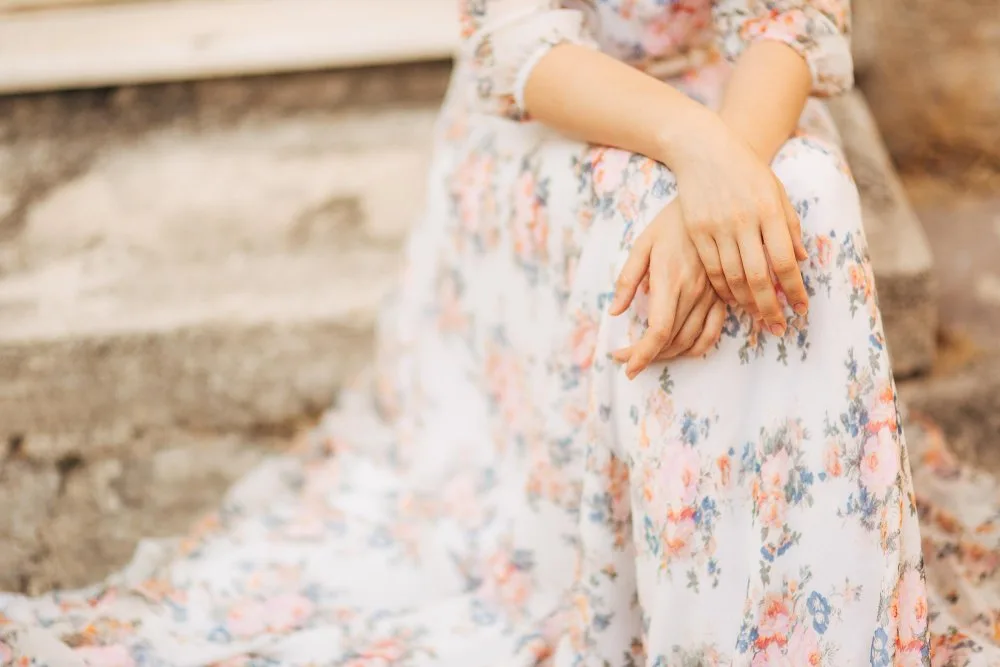
Fashion and Apparel
Cambric’s versatility shines in fashion applications. Premium-grade versions transform into flowing summer dresses, tailored business shirts, and elegant tunics that maintain crisp lines through humid days. The fabric’s ability to hold structure makes it ideal for garments with pleats, pintucks, or detailed embroidery work.
Interior designers favor cambric for its light-filtering properties. The fabric softens sunlight while preserving privacy, making it perfect for bedroom curtains, nursery window treatments, and indoor canopies. The tight weave provides excellent stability for intricate embroidery on table runners, decorative pillowcases, and heirloom pieces.
Economical variants serve practical roles as durable napkins, smooth garment linings, and handkerchiefs. A 2023 hospitality industry survey revealed that 68% of luxury hotels now use cambric for bed linens due to its wrinkle-resistant qualities and ability to withstand commercial laundering.
Is Cambric Cotton Good for Summer?
Absolutely. Cambric cotton is one of the best fabrics for summer wear. Its lightweight construction (90-95 GSM) allows air to circulate freely, keeping you cool in hot weather. The breathable weave wicks moisture away from your skin, preventing that sticky feeling during humid days. Unlike heavier cottons, cambric doesn’t weigh you down or trap heat against your body.
The fabric’s semi-opaque nature means you get adequate coverage without the bulkiness of heavier fabrics. Summer shirts, dresses, and lightweight pants made from cambric stay comfortable even in temperatures exceeding 85°F (29°C). The crisp texture also helps the fabric stand slightly away from your skin, creating tiny air pockets that enhance cooling.
Is Cambric Winter or Summer Fabric?
Cambric is primarily a summer fabric, but it works for mild winter conditions too. The fabric excels in spring and summer when you need breathable, lightweight clothing. However, cambric’s versatility extends to early fall and mild winter climates where temperatures stay above 50°F (10°C).
In winter, cambric works well as a layering piece under sweaters or jackets. The smooth texture prevents bunching and doesn’t add bulk to your outfit. Some people wear cambric shirts with cardigans or blazers for indoor wear during winter months. However, for harsh winter conditions or outdoor activities in cold weather, heavier fabrics like flannel or wool provide better insulation.
Can We Wear Cambric Cotton in Winter?
Yes, you can wear cambric cotton in winter with proper layering. While not a standalone winter fabric, cambric serves as an excellent base layer or mid-layer in cold weather wardrobes. Pair cambric shirts with thermal underwear underneath and wool sweaters or jackets on top for adequate warmth.
The fabric’s breathability actually works in your favor during winter by preventing overheating when you’re indoors or active. The smooth finish layers comfortably without creating bulk, making cambric ideal for professional settings where you need to look polished while staying warm. Many people choose cambric for winter office wear since indoor heating keeps buildings comfortable.
Embroidery and Needlework
Cambric has a long history as a premier fabric for embroidery and fine needlework. The tight weave provides a stable base that doesn’t distort under the weight of thread, making it perfect for detailed hand embroidery, eyelet lace, and cutwork.
The smooth surface allows needles to pass through cleanly without snagging, while the fabric’s body helps stitches maintain their shape. Heirloom sewers particularly value Swiss cambric or batiste for christening gowns, vintage-style blouses, and delicate baby clothes where fine stitching showcases the fabric’s quality.
Sustainability and Organic Certifications
As consumers increasingly prioritize environmental responsibility, sustainable cambric options have become widely available. Understanding certifications and eco-friendly production helps you make informed choices that align with your values.
Understanding GOTS Certification
The Global Organic Textile Standard (GOTS) represents the gold standard for organic cotton certification. GOTS-certified cambric must meet strict requirements throughout the entire production process, from farming to finishing.
For fabric to earn GOTS certification, it must contain at least 70% organic fibers (most cambric is 95% or 100% organic cotton). The certification verifies that cotton is grown without synthetic pesticides, fertilizers, or genetically modified seeds. Processing standards prohibit harmful chemicals, require wastewater treatment, and ensure safe working conditions for textile workers.
Organic vs. Conventional Cambric
Organic cambric cotton offers several advantages beyond environmental benefits. The absence of chemical residues makes it gentler on sensitive skin, particularly important for baby clothes and undergarments. Organic farming practices improve soil health, conserve water (using 91% less water than conventional cotton), and protect farm workers from pesticide exposure.
Conventional cambric costs 20-40% less than organic versions but carries environmental costs. Conventional cotton farming uses approximately 16% of global insecticides and 7% of pesticides despite occupying only 2.5% of agricultural land. These chemicals can persist in finished fabric, potentially causing skin irritation in sensitive individuals.
Other Sustainability Certifications
OEKO-TEX Standard 100 tests finished fabric for harmful substances, ensuring it’s safe for human contact. This certification doesn’t require organic cotton but verifies that the final product is free from over 100 regulated and unregulated chemicals.
Organic Content Standard (OCS) tracks organic material through the supply chain, verifying the percentage of organic content in final products. OCS focuses on material sourcing rather than processing methods.
Fair Trade Certified fabric ensures farmers receive fair prices and workers enjoy safe conditions with fair wages. This certification addresses the social sustainability aspect often overlooked in textile production.
Low-Impact Dyes and Finishing
Sustainable cambric production increasingly uses low-impact fiber-reactive dyes that require less water, produce less wastewater, and don’t contain heavy metals or toxic chemicals. Natural dyes from plants, minerals, and insects provide another eco-friendly option, though they typically cost more and offer a more limited color range.
Mechanical calendering (using pressure alone) creates a more sustainable finish than chemical treatments. Some manufacturers now use enzymatic finishing processes that achieve similar results with biodegradable enzymes instead of harsh chemicals.
How to Identify Quality Cambric
Not all cambric is created equal. Learning to recognize quality helps you invest in fabric that performs well and lasts longer.
Premium Quality
- Thread count: 90-100+ threads per inch
- Weight: 85-90 GSM (lighter but denser)
- Finish: Lustrous sheen, perfectly smooth surface
- Certifications: GOTS, OEKO-TEX, or similar
- Cotton source: Egyptian, Pima, or Supima cotton
- Price range: $15-50 per yard
- Best for: Heirloom sewing, luxury garments, special occasions
Standard Quality
- Thread count: 60-80 threads per inch
- Weight: 90-95 GSM
- Finish: Smooth with subtle sheen
- Certifications: May have basic safety certifications
- Cotton source: American Upland or standard cotton
- Price range: $6-15 per yard
- Best for: Everyday clothing, quilting, general sewing
Economy Quality
- Thread count: Under 60 threads per inch
- Weight: 95+ GSM (heavier, looser weave)
- Finish: Less refined, minimal sheen
- Certifications: Usually none
- Cotton source: Standard or blended with polyester
- Price range: $3-6 per yard
- Best for: Testing patterns, practice projects, linings
Quality Testing Methods
The Scratch Test: Lightly scratch the fabric surface with your fingernail. Quality cambric should not show threads pulling apart or fuzzing. If the weave loosens easily, the thread count is too low.
The Light Test: Hold the fabric up to light. Premium cambric shows a uniform, dense weave with minimal light penetration. Uneven light patterns or visible gaps indicate lower quality or inconsistent weaving.
The Drape Test: Let the fabric hang naturally. Quality cambric drapes smoothly without excessive stiffness or limpness. It should hold some shape while flowing elegantly.
The Feel Test: Quality cambric feels smooth and cool to the touch, with no rough patches or slubs. The calendered finish should be consistent across the entire width.
Regional Variations
Pakistani and Indian Cambric: The South Asian market specializes in printed cambric suits, particularly lawn suits that have become cultural staples. These fabrics often feature vibrant digital prints, intricate embroidery, and seasonal collections. Pakistani cambric typically comes in coordinated three-piece sets (shirt, pants, dupatta) with matching designs.
Western Cambric: European and American cambric focuses on solid colors or subtle patterns for professional wear, linens, and embroidery bases. Swiss cambric represents the premium segment, prized for heirloom sewing and luxury garments.
Artisan Applications: Japanese and European artisans favor high-thread-count cambric for sashiko embroidery, quilting, and fine needlework where the stable weave supports detailed stitching.
Care and Maintenance
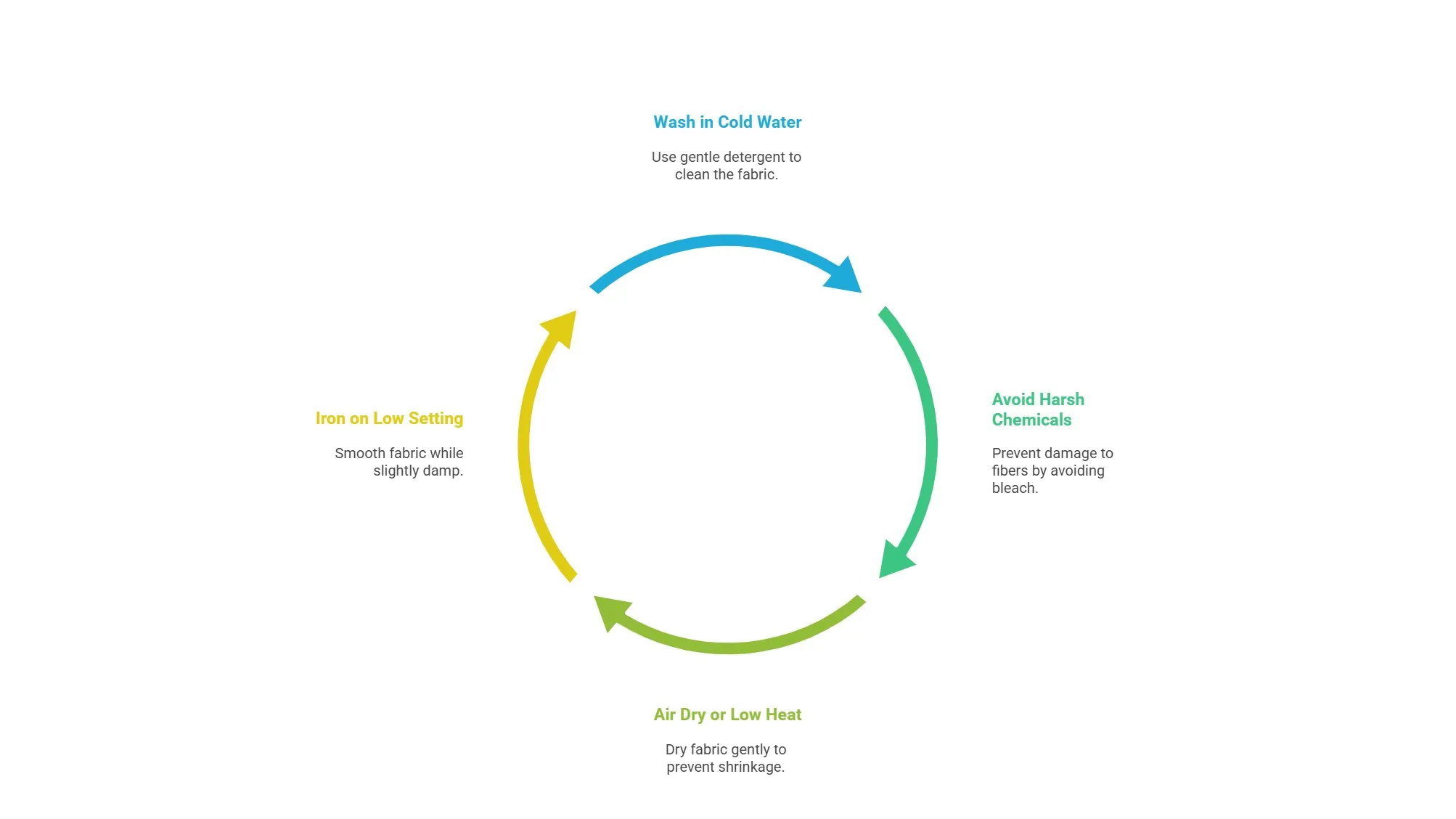
Proper care extends cambric’s lifespan and maintains its refined appearance. Follow these guidelines to keep your cambric garments and textiles looking their best.
Washing Techniques
Hand Washing (Preferred Method): Fill a basin with cold water and add mild detergent specifically formulated for delicate fabrics. Gently swish items without twisting or wringing. Cambric’s tight weave makes it more durable than it appears, but aggressive handling can distort the fabric’s shape. Rinse thoroughly in cold water until no soap residue remains. For personalized care instructions, try our Cotton Care Calculator.
Machine Washing: When machine washing is necessary, use these settings for best results:
- Select delicate or gentle cycle
- Use cold water (60°F/15°C or below)
- Place items in mesh laundry bags to prevent snags
- Wash with similar colors and weights
- Use mild, liquid detergent (avoid pods near cambric)
- Skip fabric softeners (they can build up and reduce breathability)
Drying Methods
Air Drying (Best Option): Lay cambric items flat on clean towels, reshaping gently to original dimensions. Avoid hanging wet cambric, as moisture weight can stretch the fabric. For larger items like curtains, use a drying rack with adequate support. Air drying typically takes 4-8 hours depending on humidity and air circulation.
Machine Drying: If you must use a dryer, select the lowest heat setting and remove items while slightly damp. Over-drying causes excessive wrinkling and can weaken fibers over time. Add wool dryer balls to reduce wrinkles and static without chemical fabric softeners.
Ironing and Pressing
Cambric benefits from ironing to restore its crisp appearance. Set your iron to the cotton setting (approximately 400°F/204°C) and use these techniques:
- Iron while fabric is slightly damp for easier wrinkle removal
- Use a pressing cloth for dark colors or printed fabric
- Iron on the reverse side to protect the calendered finish
- Use steam for stubborn wrinkles
- Store garments on hangers immediately after ironing
Stain Removal
Fresh Stains: Blot immediately with a clean, white cloth. Don’t rub, which can spread the stain or damage fibers. For most stains, cold water works best as hot water can set protein-based stains.
Oil-Based Stains: Sprinkle baking soda or cornstarch on the stain to absorb oil. Let sit for 15-20 minutes, brush off, then treat with dish soap before washing.
Stubborn Stains: Create a paste with baking soda and water, or use white vinegar diluted 1:1 with water. Apply to the stain, let sit for 30 minutes, then rinse and wash normally. Avoid bleach, which weakens cotton fibers and can yellow white fabric over time.
Storage Tips
Store cambric in cool, dry places away from direct sunlight, which can fade colors and yellow white fabric. Use breathable cotton garment bags rather than plastic, which traps moisture and can promote mildew growth. For embroidered or heirloom pieces, wrap in acid-free tissue paper to prevent color transfer and protect delicate work.
Fold cambric along different lines each season to prevent permanent creases. Cedar blocks or lavender sachets deter moths without the harsh chemicals found in mothballs.
Troubleshooting Common Problems
Loss of Crispness: If cambric becomes limp after washing, the calendered finish has relaxed. Restore some structure by using spray starch during ironing, or mix 1 tablespoon of cornstarch in 2 cups of water, spray lightly, and iron.
Yellowing: White cambric can yellow from body oils, improper storage, or age. Soak in a solution of 1 cup white vinegar per gallon of cold water for 30 minutes before washing. For persistent yellowing, use oxygen-based bleach (never chlorine bleach) following package directions.
Pilling: While cambric resists pilling better than most cotton, friction areas may develop pills. Use a fabric shaver or pill comb to gently remove them. Prevent future pilling by turning garments inside out before washing.
Buying Guide and Price Range

Where to Buy Cambric Cotton
Online Fabric Retailers: Offer the widest selection with detailed specifications, customer reviews, and often sample swatches. Look for retailers that provide thread count, GSM, and width information. Request samples before buying large quantities for important projects.
Local Fabric Stores: Allow you to feel the fabric’s hand and see colors in person. Staff can often provide advice on project suitability and care requirements. Building relationships with local shops can lead to special orders and bulk discounts.
Specialty Suppliers: Heirloom sewing and embroidery suppliers stock premium Swiss cambric and batiste. These sources typically offer superior quality at higher prices but prove worthwhile for special projects.
Price Expectations
Budget Range ($3-6 per yard): Entry-level cambric, often polyester blends or lower thread counts. Suitable for practice projects, testing patterns, or short-term use items.
Mid-Range ($6-15 per yard): Standard quality cotton cambric perfect for everyday clothing, quilting, and general sewing projects. This range offers the best value for most applications.
Premium Range ($15-30 per yard): High thread count, often GOTS certified organic cotton with Egyptian or Pima fibers. Ideal for garments you’ll treasure for years, heirloom pieces, and luxury bedding.
Luxury Range ($30-50+ per yard): Swiss Nelona or similar premium batiste with exceptional fineness and hand. Reserved for christening gowns, vintage reproductions, and museum-quality work.
How Much Fabric to Buy
Always purchase 10-20% extra fabric beyond pattern requirements to account for shrinkage, pattern matching (for prints), and mistakes. For cambric, which typically shrinks 2-3% in the first wash, pre-washing is essential before cutting. Buy an additional half yard for each garment if you’re new to sewing or making adjustments to patterns. Our Fabric Yardage Calculator can help you determine exactly how much fabric you need for your project.
Questions to Ask When Buying
- What is the thread count?
- Has the fabric been pre-shrunk?
- What is the fiber content (100% cotton or blend)?
- Does it have any certifications (GOTS, OEKO-TEX)?
- What is the fabric width?
- Is it colorfast/has it been tested for bleeding?
- What is the return policy if it doesn’t meet expectations?
Frequently Asked Questions
Cotton cambric is semi-opaque, meaning it’s not see-through in most colors and weights. Light colors like white, cream, or pastels may show some transparency, especially in bright light, but darker colors and prints provide adequate coverage without lining. Higher thread counts (80-100) offer more opacity than lower counts. For complete opacity in light colors, choose cambric with 80+ thread count or use a lightweight lining.
Yes, cambric is an excellent fabric choice for many applications. It offers a rare combination of lightweight comfort, durability, and refined appearance. The fabric breathes well, resists wrinkles better than many cottons, and maintains its shape through repeated wear and washing. Cambric works beautifully for summer clothing, embroidery projects, and items requiring a polished look without heavy weight. Its main limitation is lack of warmth for cold weather, but for spring through fall wear, cambric performs exceptionally well.
This question involves a bit of confusion about fabric terms. Cambric IS cotton (or historically linen). The question probably means: “Is cambric thicker than other cotton fabrics?” The answer depends on which cotton you’re comparing. Cambric (90-95 GSM) is thicker than voile (60-70 GSM) and similar to batiste, but thinner than poplin (120-140 GSM) or broadcloth (130-150 GSM). Among lightweight dress cottons, cambric sits in the medium range.
Wearing cambric offers multiple benefits: excellent breathability keeps you cool in warm weather, the smooth finish feels gentle against sensitive skin, the fabric wicks moisture efficiently, it maintains a crisp, professional appearance throughout the day, it’s lightweight without being fragile, the tight weave resists pilling and snagging, it’s hypoallergenic and suitable for all skin types, and it’s easy to care for with standard washing. Additionally, cambric holds dye and prints well, offering great versatility in colors and patterns.
No, cambric cotton is not waterproof. As a natural cotton fabric, cambric is actually quite absorbent and will soak up water. The tight weave offers some initial water resistance (water beads on the surface briefly), but the fabric will absorb moisture within seconds. This absorbency is actually a benefit for clothing since it helps wick sweat away from your body. If you need waterproof fabric, look for treated cotton with DWR coating or synthetic waterproof fabrics.
This compares a general category with a specific type, like asking “which is better, fruit or apples?” Cambric IS cotton, just a specific type with particular characteristics. The better question is which TYPE of cotton works best for your needs. Choose cambric if you want: lightweight fabric with structure, smooth finish with subtle sheen, good breathability for summer wear, a fabric that works well for embroidery. Choose other cotton types like canvas for durability, flannel for warmth, or jersey for stretch.
Identify cambric by these characteristics: smooth, even surface with subtle sheen from calendering, crisp hand that’s firmer than voile but softer than poplin, tight plain weave visible when held to light, semi-opaque appearance (not sheer), thread count typically 60-100 per inch, slight stiffness that relaxes with washing, drapes well while maintaining some body. The fabric should feel cool and smooth to touch. If uncertain, compare with known samples of voile (softer, more fluid) and poplin (heavier, more textured).
Cambric is primarily worn in spring and summer when its breathability and lightweight nature provide maximum comfort. The fabric excels in temperatures from 65-95°F (18-35°C). However, cambric extends into fall and mild winter as a layering piece or for indoor wear. In South Asian countries, cambric suits are particularly popular during pre-monsoon and post-monsoon periods when weather is warm but not intensely hot. The fabric’s versatility makes it suitable for three seasons in most climates, with winter wear depending on your region’s temperatures.
Conclusion
Cambric cotton stands as a testament to how traditional textile craftsmanship can meet modern needs. This fabric, with its 700-year history spanning from medieval French workshops to today’s sustainable textile mills, offers a unique combination of refinement and practicality that few fabrics match.
The journey from flax-based linen to premium cotton showcases cambric’s adaptability while maintaining its core qualities: that signature smooth finish, crisp yet comfortable hand, and versatile performance across applications. Whether you’re selecting fabric for a summer wardrobe, starting an embroidery project, or choosing sustainable bedding, cambric delivers consistent quality.
Key Takeaways
- Seasonal Versatility: Cambric excels primarily as summer and spring fabric but works year-round with proper layering. Its breathability and lightweight nature (90-95 GSM) make it ideal for warm weather while remaining comfortable for mild winter indoor wear.
- Quality Indicators: Look for 80-100 thread count for premium fabric, smooth calendered finish, GOTS or OEKO-TEX certification for sustainable options. Don’t hesitate to request samples before purchasing large quantities.
- Care Essentials: Pre-wash before cutting patterns to account for 2-3% shrinkage. Use cold water and gentle cycles, air dry when possible, and iron while slightly damp for best results. Proper care extends fabric life to 5-10 years.
- Fabric Comparisons: Cambric is crisper than voile, slightly heavier than lawn, firmer than batiste, and lighter than poplin. Understanding these differences helps match fabric to project needs.
- Sustainability Matters: GOTS-certified organic cambric uses 91% less water than conventional cotton and eliminates exposure to harmful pesticides. The 20-40% price premium supports environmental health and worker safety.
- Application Range: From delicate embroidery to structured business wear, from nursery curtains to luxury hotel linens, cambric adapts to diverse needs while maintaining its refined character.
Making Your Decision
When choosing cambric, consider your specific needs. For everyday summer clothing and general sewing projects, standard quality cambric ($6-15/yard) provides excellent value. Investment in premium cambric ($15-30/yard) makes sense for heirloom pieces, special garments, or items you’ll use frequently over years. Budget options work fine for practice projects and pattern testing.
If you’re new to working with cambric, start with a small project like a simple dress, pillowcase, or beginner-friendly pattern. This allows you to experience the fabric’s properties firsthand before committing to larger investments or complex projects. Many sewers find cambric easier to work with than expected, thanks to its stability and forgiving nature.
Looking Forward
The textile industry’s shift toward sustainability positions cambric well for the future. As consumers demand transparency and environmental responsibility, GOTS-certified cambric and other organic options become more accessible and affordable. The fabric’s natural properties align perfectly with current trends favoring breathable, comfortable clothing over synthetic fast fashion.
Digital printing technology continues to expand cambric’s design possibilities, offering custom prints and small-batch production that wasn’t economically feasible a decade ago. This democratization means independent designers and home sewers can access the same quality fabric and printing services once reserved for large manufacturers.
Whether you’re drawn to cambric for its historical significance, environmental credentials, or practical performance, this fabric offers a compelling choice for modern wardrobes and home textiles. The combination of heritage craftsmanship and contemporary sustainability makes cambric cotton more relevant today than ever before.
As you explore cambric for your projects, remember that quality matters more than quantity. One well-made cambric garment that lasts five years provides better value and environmental impact than multiple cheaper alternatives that wear out quickly. Take time to feel fabrics in person when possible, request samples for important projects, and don’t hesitate to invest in quality for items you’ll treasure.
The enduring appeal of cambric cotton lies in its honest simplicity. It doesn’t rely on technical coatings or synthetic fibers to perform well. Instead, it offers the timeless benefits of natural cotton, enhanced through careful weaving and finishing techniques perfected over centuries. In an era of overcomplicated fabric choices, cambric’s straightforward excellence feels refreshingly authentic.

